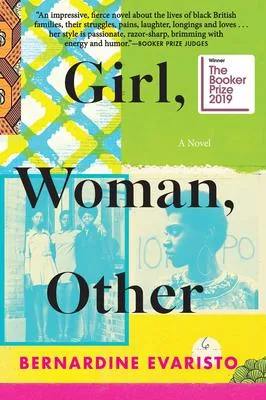Each of the first four chapters of Bernardine Evaristo’s Girl, Woman, Other tells the stories of three black British women whose lives are connected in different ways. In the first for example, we meet the radical lesbian playwright Amma, who is eagerly anticipating the National Theatre premiere of her play The Last Amazon of Dahomey; next we meet her daughter Yazz, and then Amma’s best friend Dominque. Chapter Two features a high-powered banker named Carole, her mother Bummi, an immigrant from Nigeria who works as a cleaner, and then Carole’s schoolmate LaTisha, who works retail. The third chapter starts off with Amma’s lifelong friend Shirley, an embittered schoolteacher, followed by Shirley’s mother Winsome, and then Shirley’s teaching colleague, Penelope, who is white, unlike all the other characters. (But appearances turn out to be deceiving.). The last of these triad chapters tells the stories of women from the same family: it starts with a character named Megan who transitions to Morgan, then introduces their great-grandmother Hattie (a delightfully tough and cranky old bird) and concludes with the heartbreaking story of Hattie’s mother Grace. The novel’s closing chapter is called “The After Party,” a celebration of the triumphant opening night of Amma’s play, wherein many of the aforementioned characters bump into each other.
The novel is not only structurally inventive, but stylistically bold too. Evaristo is a wizard at creating full, lively worlds for each character with direct, stripped down prose:
“that night she couldn’t sleep / she went to war with her morals on behalf of her feelings / guess which side won? / she was nearly fifty / she deserved to have this / him”
Racism is part of each woman’s story, but in different ways. For example, when Winsome and her husband leave 1950s London to seek their fortune in a smaller town,
“you can’t work here, they said, when Clovis asked down at the quay / you can’t eat here, they said when we entered a little caff / you can’t drink here, the barman said when we entered a pub, all eyes on us / you can’t sleep here because your colour will come off on the sheets, said the woman who had a sign for lodgings in her window”
However for Carole, in her first year at Oxford University decades later, the racism is more subtle: “people walked around her or looked through her, or was she imagining it? did she exist or was she an illusion? if I strip off and streak across the quadrangle will anyone notice me other than the porters who will no doubt call the fedz, an excuse they’ve been waiting for ever since they first set eyes on her when a student sidled up after a lecture to ask for some ecstasy, Carole almost texted her mother to say she was on the next train home”
For this reader, the epilogue that ends the novel stretches credulity a bit and teeters on the edge of sentimentality. But never mind. Girl, Woman, Other is an open-hearted, wise, compassionate, and finely wrought portrait of black womanhood in all its complexity. As far as I’m concerned, it’s a must read, and a deserving co-winner of last year’s Booker Prize.
– JoAnn

